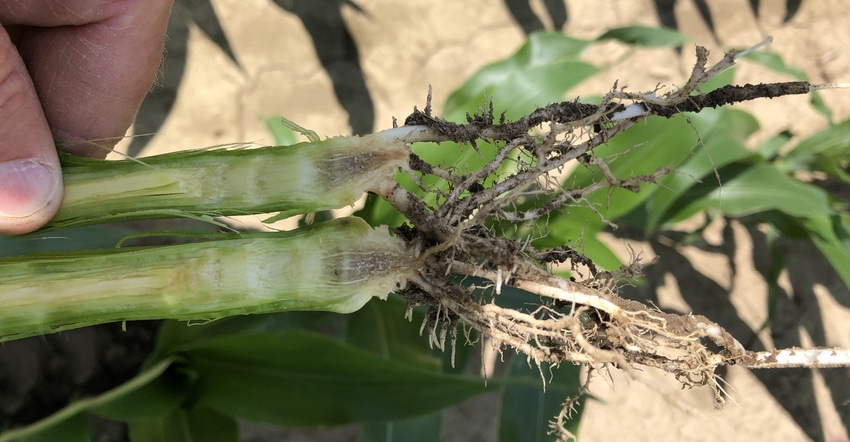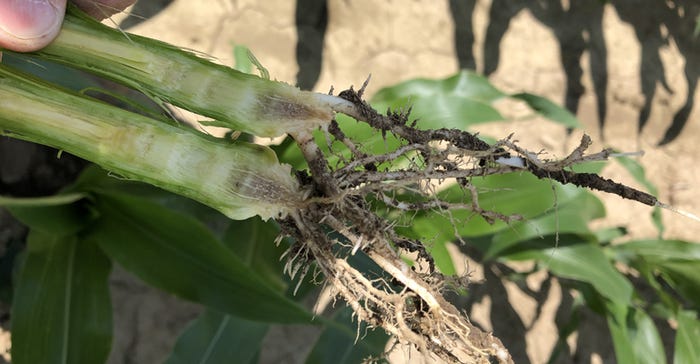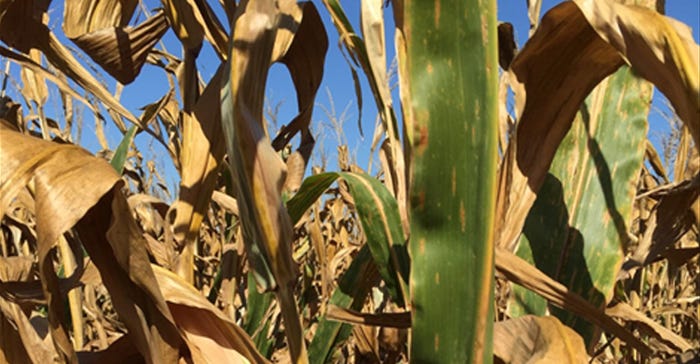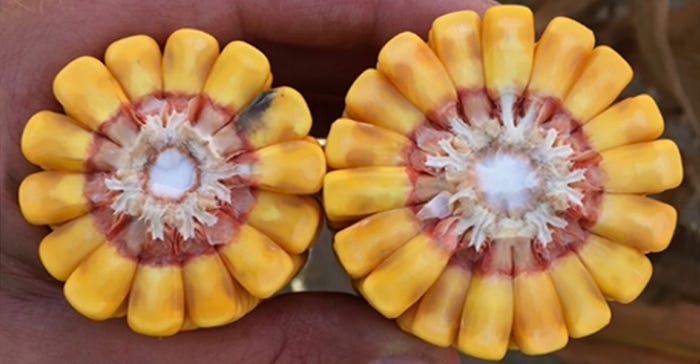August 1, 2019

Sponsored Content
Crown rot infections are caused by both fusarium and pythium species. These fungi enter the plant via the root system during periods of prolonged saturation, predominately between the V2 and V7 growth stage. Because these fungi persist in higher moisture environments, infections are more prevalent in wetter soils, tighter clay soil textures, higher magnesium soils, and ponded areas of fields. While these infections occur early in corn development, they can persist much longer as the visual signs are not easily detected until later in the grain fill period.
The crown area serves as the "highway" through which moisture and nutrients extracted by the root system are mobilized into the stalk. The crown of a healthy corn plant will be a white-green color with firm flesh. The crown of a fusarium or pythium infected plant is tan or brown.
Often, the plant will continue to grow and develop despite infection due to the generation of new nodal and brace roots. Some may say that the plant "outgrows" crown rot. The new roots continue to provide access to additional moisture and nutrients, and the plant survives, albeit with a reduced vascular system.

Despite the fact that the plant appears to recover, the infection continues to develop. As it does, it obstructs the "highway", making it more difficult for the plant to move nutrients and water from the roots to the rest of the plant. Plant stress is compounded with increased remobilization of nutrients during grain fill. Ultimately, the plant succumbs to a premature death—a condition known as PMD.
The impact of PMD typically results in smaller ear sizes and lower test weight. It also often leads to stalk lodging or breakage at the soil level (crown region) or just above. In addition to the fungal infection, late planting compounds stress due to shortened day length during the grain fill period.
While fungicide seed treatments do protect against fusarium and pythium species in the seedling stage, the treatment does not persist long enough to protect corn from these crown rot diseases. Some hybrids are more susceptible than others, but it’s important to note that currently there are no hybrids completely resistant to these fungal pathogens.


MANAGEMENT STRATEGIES TO MITIGATE CROWN ROT AND PMD
Fungicide treatments made between the VT and late brown silk stage can help reduce the effects of PMD by reducing stress, decreasing ethylene production, and simply keeping the plant alive longer.
While no current fungicides are completely systemic (mobile in the xylem and phloem), anecdotal evidence suggests that fungicide applications made between the V5 and V7 growth stage can help minimize crown rots and PMD. If applied later (V8 and beyond), no adjuvants containing NPE should be used with the fungicide treatment. This is because adjuvants can lead to arrested ear development. This includes adjuvants that are within many POST herbicide applications. (Ex: Roundup PowerMAX®)
Row cultivation on corn that is just beginning to show crown discoloration may be beneficial. Moving the soil up around the crown can also promote nodal root development and reduce the impact of early crown infection.
Crown rot contributes to the degradation of stalk integrity and infected plants are at risk for lodging. Scouting fields for signs of crown rot can help you to make a harvest plan and prioritize early harvest for affected fields. The costs of drying grain may be less than the value of grain lost due to complications of harvesting downed corn.
Crown rot cannot be cured, but scouting to determine its presence in your field allows you to make important management decisions. Applying a fungicide mitigates damage and prioritizing harvest reduces harvest losses due to lodging. Crown rot is the next threat in an already trying season, but with preparation, and a solid plan you can manage this condition in your fields. Reach out to your local Beck’s representative for more details on managing crown rot infection.
About the Author(s)
You May Also Like




